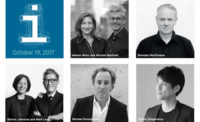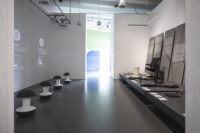2019 Innovation Conference Considers the Changing Nature of Practice

Nader Tehrani, Dean, The Irwin S. Chanin School of Architecture, Cooper Union
Photo © Architectural Record

Photo © Architectural Record

Billie Faircloth, AIA, Partner, KieranTimberlake
Photo © Architectural Record

Phillip Bernstein, FAIA, Associate Dean and Senior Lecturer, Yale School of Architecture
Photo © Architectural Record

Yvonne Farrell, Co-Founder, Grafton Architects
Photo © Architectural Record

Michel Rojkind, Senior VP of Architecture, WeWork
Photo © Architectural Record

Fiona Cousins, Principal, Arup
Photo © Architectural Record

Fiona Cousins, Principal, Arup
Photo © Architectural Record

Francis Kéré, Founder & Principal, Kéré Architecture
Photo © Architectural Record

Marlon Blackwell, Principal, Marlon Blackwell Architects
Photo © Architectural Record

Marlon Blackwell, Principal, Marlon Blackwell Architects
Photo © Architectural Record

Ma Yansong, Founder & Principal Partner, MAD Architects
Photo © Architectural Record

Ma Yansong, Founder & Principal Partner, MAD Architects
Photo © Architectural Record

Norman Foster, President, Norman Foster Foundation, Founder and Executive Chairman of Foster + Partners
Photo © Architectural Record

Winning entries of the 2019 Cocktail Napkin Sketch Contest
Photo © Architectural Record















On October 29, hundreds of architects and design professionals attended Architectural Record’s annual Innovation Conference, held at the New School. Titled “Igniting Change: How Creativity, Design, and Technology Will Shape the Future,” the event featured a diverse group of speakers with wide-ranging ideas on what constitutes “innovation,” and how to integrate it into practice.
Kicking off the conference, Nader Tehrani, principal of the Boston-based firm NADAAA, spoke about the pedagogical approach of Cooper Union—where he is dean of the Irwin S. Chanin School of Architecture—to prepare students for professional life in an industry whose relationship to digitization is in a constant state of flux. With a steady stream of new technologies, software quickly becomes outdated. “If we prepare students for today’s workforce, then they will be completely ill-prepared for the field 5 years when they graduate,” said Tehrani. Instead, at Cooper Union, questions are asked in ways to give students space to discover didactive motives through the process of research. According to him, the best way to create an environment ripe for innovation is to encourage young architects to “improvise and be at ease with uncertainty.”
Other speakers—including Billie Faircloth, a past Women in Architecture award winner and partner at Philadelphia-based Kieran Timberlake; Phil Bernstein, associate dean at the Yale School of Architecture and former vice president at Autodesk; and Fiona Cousins, principal at Arup—all discussed different aspects of how the design and construction industry is transforming in the information era. Using Kieran Timberlake’s work as an example, Faircloth spoke of the importance of materials research in practice. The firm reinvests profit into experimentation in order to build a robust research component. Its probing design process relies heavily on prototypes and mock-ups that accelerate previous research and contributes to a database of knowledge to be used not just by the firm, but by the profession as a whole. “We believe in sharing our findings. The transformation of the profession is most important,” said Faircloth.
Bernstein also lectured on the importance of systematic exploration, simulation, and analysis for future business models. Bernstein criticized current practices, such as overreliance on tools like BIM, “which drag us down into the old systems of doing things,” he said. The problem, per Bernstein, is that buildings are “understood in terms of professional standards, licensure, and defining ‘intent’,” which slow down the design and construction process and create gratuitous complexity. “The value of architecture has been straight commodified,” he said. In order to create new value for the future, he suggested alternative business models that are based on outcomes instead of cost. “It’s all about making stuff happen.”

As in Bernstein’s talk, Cousins shed light on current practices in the AEC industry that must be evolved. Speaking of the tangled relationships between architects, engineers, and contractors, she noted “the inevitable loss of knowledge and value as documents and responsibilities are passed around to different players in the construction process.” She discussed the barriers of digital transformation among different generations of professionals, and ways in which members of the AEC industry can better harness the power of data and risk management in order to improve efficiency, citing Katerra as an example of a more streamlined business model.
Yvonne Farrell, co-founder of Dublin-based Grafton Architects, which recently won the 2020 RIBA Gold Medal; Mexican architect Michel Rojkind, founding partner of Rojkind Arquitectos and WeWork’s senior vice president of architecture; and Berlin-based Francis Kéré all discussed the ways in which they create "humane" spaces that celebrate and include the communities that surround their buildings. “Architecture is not a collection of buildings, but, rather, a container of life,” said Farrell, who presented projects such as the dramatic, vertical concrete campus for UTEC in Lima, Peru, as well as the Marshall Building at the London School of Economics, which is lifted above ground to connect to the streetscape.

In talking about craft in his native Mexico, Rojkind emphasized the cultural importance of architecture, from using local craftsmen for the manufacturing of construction elements, to creating opportunities for the inclusion of public space in buildings—such as a grocery store or a cinema—that otherwise would not provide such areas. “Living in an era of digital images, the need for tangibility and realness arises,” said Rojkind. “Craft slows us down, and gives us the ability to do things in a more meaningful way,” he said. “If we engage people and expand their curiosity—if we care about all of us—we will have better outcomes,” he said.
Kéré presented work completed in his home country of Burkina Faso. He explained how, by using local labor and materials, he was able to bring the spirit of transformation to the capital city Ouagadougou, through the construction of simple buildings to house schools and a hospital. “Africa is not a place of progress, but a place of opportunities where innovation can happen,” he said. He also shared recent work in the U.S.: a temporary installation at Coachella and a pavilion at Tippet Rise Art Center in Montana.

Architect Marlon Blackwell discussed the influence of Arkansas—where he established his eponymous firm—on his work, which includes a major park in Memphis, a pediatric clinic, and the Fay Jones School of Architecture. Describing his place of practice as “ruburbia,” Blackwell explained his process of creating a singular architecture from a mix of typologies—both vernacular and corporate buildings. To do this, he combines “culture made and nature made parts” to create works that achieve architectural diversity and economic stimulation.
Ma Yansong of MAD Architects showcased his portfolio of curved, organically-shaped buildings, including the Chaoyang Park Plaza in Beijing, the currently under construction Lucas Museum of Narrative Art—resembling a vessel taken from one of the Star Wars films—and his proposal for a contoured skyscraper on Manhattan’s East 34th street, which gradually becomes transparent as it ascends, appearing to disappear into the sky. According to Ma, his inspiration for his otherworldly buildings comes from natural forms, such as paddy fields or mountains. “I don’t want my buildings to look man-made,” said Ma.

Wrapping up the event was keynote speaker Norman Foster, who gave an overview of his illustrious career and his decades-long commitment to sustainable, energy efficient architecture. For Foster, the over-used word sustainability means “the link to the outside world.” He discussed some of his unbuilt work from the 1970s—including the autonomous house he developed with Buckminster Fuller—before showing some of his more recent projects—“breathing buildings” such as Silicon Valley’s Apple Park and the Bloomberg HQ in London. The second half of his presentation was dedicated to his humanitarian efforts through the Norman Foster Foundation, primarily in India, where he has worked directly with members of informal settlements to assist in the redevelopment of their communities. According to the architect, central to transforming these communities from within is access to electrical power energy. “Slums are not communities of despair, they are communities of hope,” said Foster.


















